REEL RETRO CINEMA: The cult-fave flick was released 43 years ago, on Dec. 5, 1980…

By ROB KELLY
Sometime around December 5, 1980, my Dad took my older sister and me to see Flash Gordon. Having read numerous Flash Gordon comics and watched hours of the movie serials, I was the perfect audience. Also in the audience that night? Two drunken young women, who seemed to be enjoying the movie for entirely different reasons. But more on them later.
After lying somewhat fallow in the pop culture landscape for a few decades, big time movie producer Dino De Laurentiis was eager to get Flash Gordon onto the silver screen. He did the trick for Danger: Diabolik and Barbarella (both 1968), and ultimately the somewhat campy approach taken with those films would be used for Flash Gordon, just a lot more family friendly.

It’s a famous story by now—one of the great What If?s in all of pop culture—that in the early 1970s, George Lucas tried to buy the rights to Flash Gordon. His failure to do so led (indirectly) to the creation of Star Wars, and popular entertainment would never be the same. De Laurentiis had first wanted Federico Fellini(!) to direct, then moved onto Nicolas Roeg(!!), finally settling on journeyman director Mike Hodges and screenwriter Lorenzo Semple Jr. (who, besides helping develop the Batman TV series, wrote the 1976 King Kong remake for De Laurentiis). With a budget of $27 million (around $100 million today), De Laurentiis was, as usual, going big.
He’s a miracle!
After a magnificently exciting opening credits scene (scored to Queens’ iconic, propulsive theme music, and peppered with art from the comic strip), we jump right to the action—by the 20-minute mark we’re already on Mongo.
Every sci-fi/fantasy film post-Star Wars bears its influence, visually and tonally. But De Laurentiis’ personality was still so big and forceful that Flash Gordon hits a sweet spot between what a big budget, modern sci-fi movie was supposed to feel like in 1980, and the more idiosyncratic, phantasmagorical, Pop Art feel of the 1960s. Almost everything in Flash Gordon is a practical effect—the retro-futuristic spaceships and weaponry, the Art Deco sets, and the costumes that look mighty uncomfortable for the actors to wear.
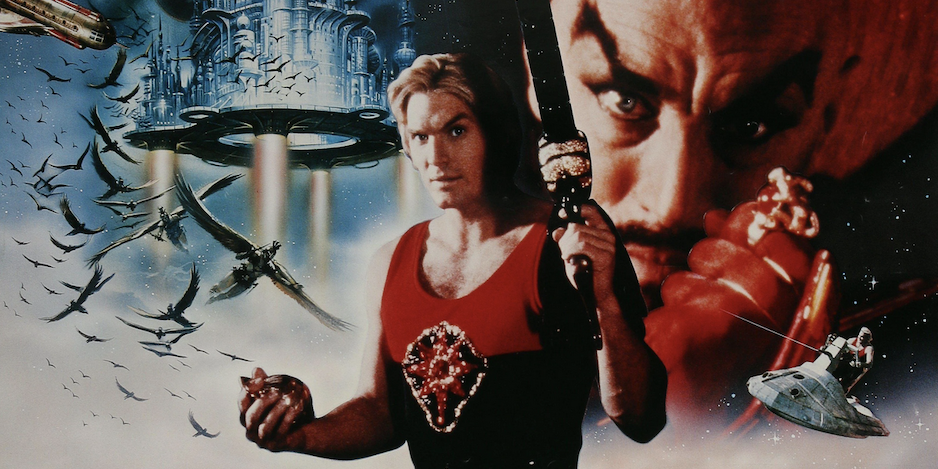
Speaking of the actors, one of the tricky parts of taking the “camp” approach is, all of them have to be on the same page as each other and the director, or it generally doesn’t work (see: 1973’s Doc Savage). As played by Sam Jones (who would, just a few years later, play another comic strip hero, Will Eisner’s The Spirit), Flash Gordon is a lovable, too-confident lunkhead who just sort of blunders into one dangerous situation after the next. Flash doesn’t even seem all that fazed when he, Dale (Melody Anderson) and Dr. Zarkov (Topol) land on another planet and meet the imposing Ming the Merciless (the late, great Max Von Sydow, having the time of his life). This is a guy who wears a t-shirt with his own name on it, so he’s not that big on introspection.
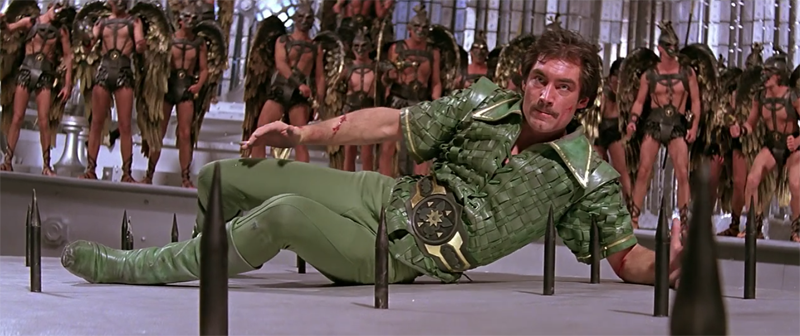
Providing absolutely stellar supporting work are future James Bond Timothy Dalton as Prince Barin, Brian Blessed (Augustus Caesar in one of my personal favorites, I, Claudius) as Vultan, and the absurdly sexy Ornella Muti as Princess Aura, who singlehandedly almost pushes Flash Gordon into the “Uh, maybe this isn’t for kids” territory occupied by Danger: Diabolik and Barbarella.
King of the impossible!
For his turn, director Mike Hodges (1971’s Get Carter, 1974’s The Terminal Man) understood the assignment, and never lets the comedy get too silly so it undercuts the action beats and eliminates the stakes. Indeed, the battle between Flash and Barin on a rotating, floating platform jutted with metal spikes is still genuinely exciting, all these years and big budget comic book movies later. The whole venture is aided immeasurably by production and costume designer Danilo Donati, who didn’t worry how impractical these outfits looked—he just built a pair of gold wings and slapped them on Brian Blessed’s back.
Speaking of, uh, backs, remember those two drunken women I mentioned? Well, they were sitting a few rows ahead of us and seemed to be in absolute rapture over Sam Jones. During the scene when Flash has to undress, they yelled “Wooo! Take it off!” while laughing hysterically. Maybe they were so loaded that they would have reacted this way to any movie playing at the time (Raging Bull, perhaps?), but I like to think it’s at least partly because they were tapping into the film’s lustier elements that I, as a small kid, was blissfully unaware of.

He’s for every one of us!
I will admit, post-the 1989 Batman, I grew a little cold on Flash Gordon. Thrilled as I was over finally having a “serious” superhero movie, I generally regarded any comic book adaptations that weren’t deadly serious as no longer worth my time. Luckily, I quickly grew out of that phase, and came back around to love Flash Gordon for all of its glorious excesses. Is it “true” to the original comic strips? No, not really. But comics are one thing and movies are another. If I want a more serious approach, there are decades of Flash Gordon strips to enjoy, the aforementioned movie serials, and the quite fun Filmation cartoon of the late 1970s. Flash Gordon the movie captures the high-flying, go-for-broke, Lizard Men-sure-why-not spirit to be found in every multimedia iteration of the character (okay, maybe not Flesh Gordon).
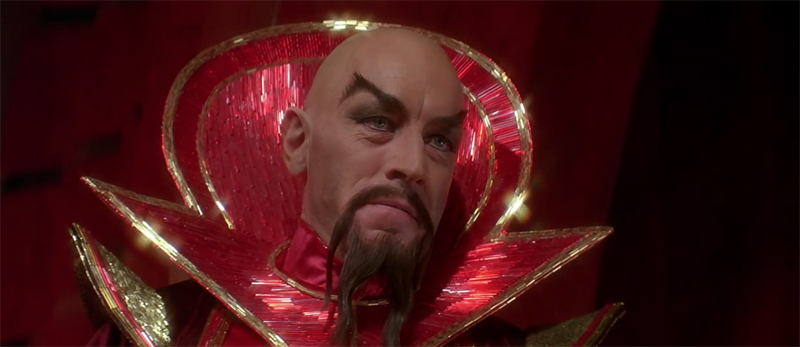
Another thing I must admit is, I have a personal stake in this movie now in a way I never have before. Last year, I found myself—in a Flash-esque streak of dumb luck—the owner of a genuine, original 1980 Flash Gordon pinball game, made by Bally. I’ve been a pinball aficionado since I was a kid, but I never thought I’d have the opportunity to actually own a machine. Certainly not one connected to one of my favorite movies, since those command Mongo-high prices.
The damn thing weighs more than Dr. Zarkov’s rocket, and it’s taken a lot of time and money to get it up and running, but when something like this falls into your lap, you can’t say no. It’s sitting a few feet away from me as I write this, and I smile every time I look at it. Like the movie itself, it’s big, loud, expensive, a little creaky in places, and I love it.
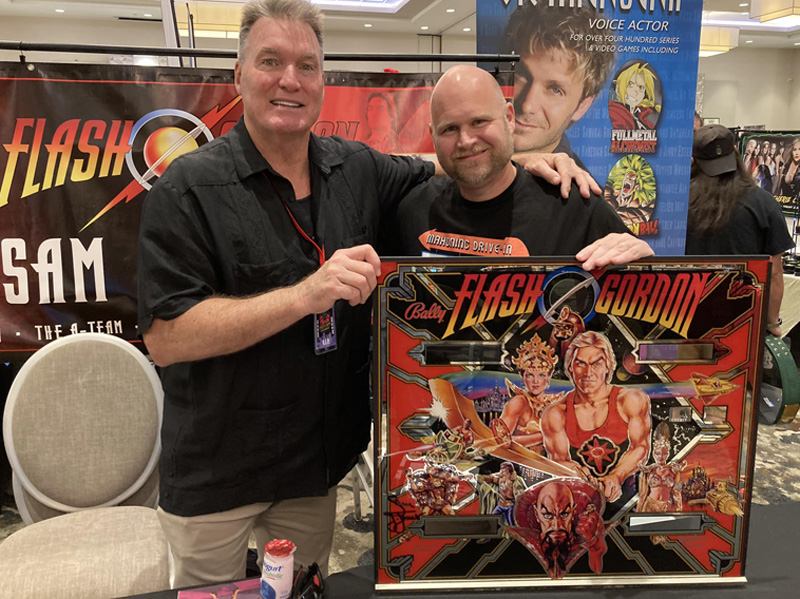
Which is why, when I saw that Sam Jones was making an appearance at a convention just a few states away back in the summer, I hatched a plan. I (carefully!) removed the beautiful back glass from the machine, secured it in enough bubble wrap to stop a bullet, and carted it several hundred miles to get Jones to sign it.
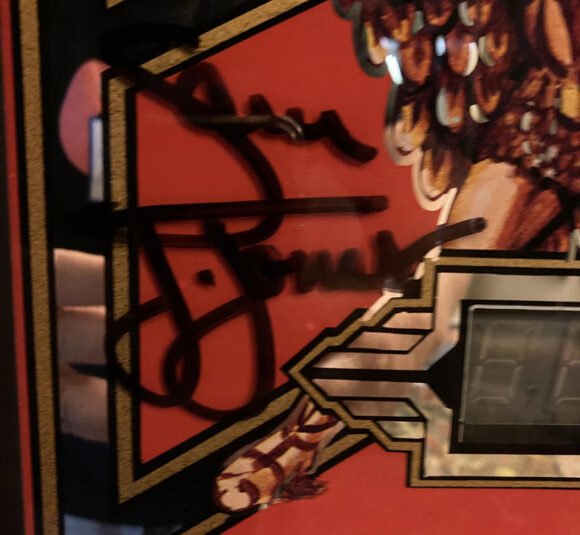
I am happy to report he did so, enthusiastically, and I got to spend a few minutes of my life talking to the Flash Gordon about pinball. As the song goes, no one but the pure in heart may find the golden grail.
—
MORE
— 13 Fabulous FLASH GORDON STRIPS: An ALEX RAYMOND Birthday Celebration. Click here.
— 13 BEAUTIFUL ILLUSTRATIONS: The FLASH GORDON of AL WILLIAMSON. Click here.
—
ROB KELLY is a podcaster, writer and film historian. He is the host of various podcasts, including Fade Out, Pod Dylan, TreasuryCast and M*A*S*HCast on The Fire and Water Podcast Network.

December 8, 2023
One of my all time favorites. I watched it not long ago with my kids and it still holds up. And the soundtrack is awesome!
December 8, 2023
The Flash Gordon soundtrack album is the only music I have ever owned on Vinyl, 8-Track, Cassette, CD, and Digital.